21.5-inch iMac (Late 2013) Review: Iris Pro Driving an Accurate Display
by Anand Lal Shimpi on October 7, 2013 3:28 AM ESTCPU Performance
I ran the entry level iMac through our normal OS X CPU test suite. I don't have a ton of Mac desktops in the database but I do have results for last year's 27-inch iMac that'll help put things in perspective. Also keep in mind that the 21.5-inch iMac came equipped with a HDD, while nearly everything else I'm comparing it to has an SSD inside.
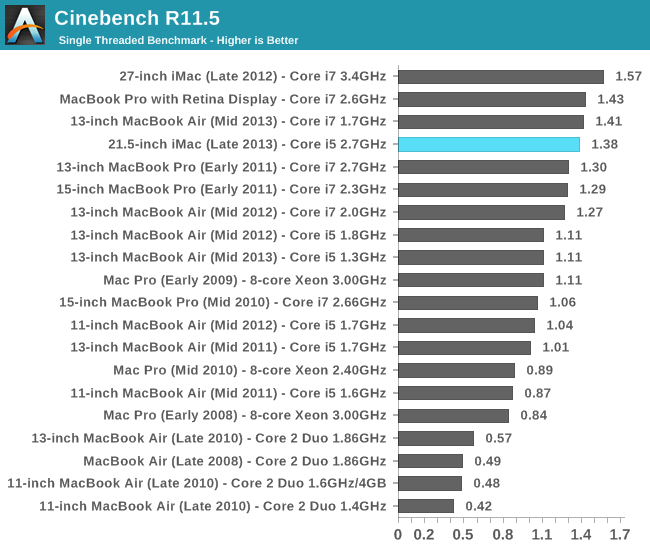
Single threaded performance is about on par with an upgraded 13-inch Haswell MacBook Air, which is sort of insane when you think about it. The Core i7 upgrade in the 13-inch MBA can turbo up to 3.3GHz, compared to 3.2GHz with the entry-level iMac’s Core i5. The amount of L3 cache dedicated to a single core is actually the same between both parts (at 4MB). In the case of Cinebench, the 128MB L4 cache doesn’t seem to do much.
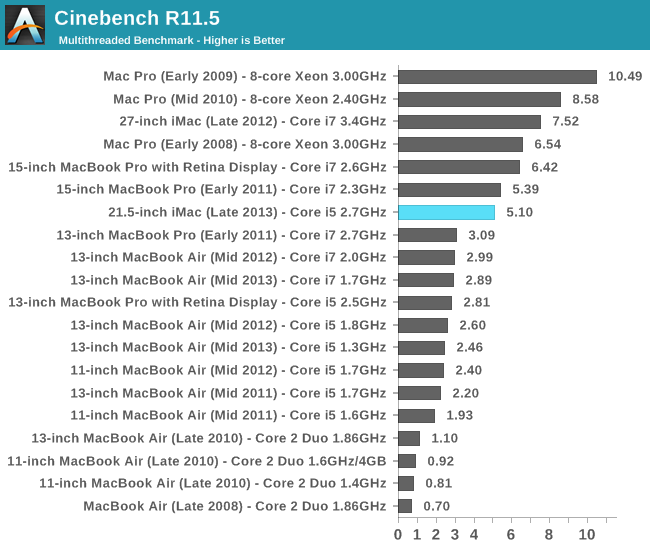
Multithreaded performance is obviously much better than what you’d get from a MacBook Air. You’ll notice the entry-level iMac’s performance here is actually quite similar to that of my old 2011 15-inch MacBook Pro. Although the Core i5-4570R has higher IPC and more TDP to work with, since it’s a desktop Core i5 it doesn’t support Hyper Threading and thus is only a 4 core/4 thread part. The Core i7 in my old MBP however is a 4 core/8 thread part, letting it make better use of each core’s execution resources in heavily threaded applications. This is really no fault of Apple’s, but rather a frustrating side effect of Intel’s SKU segmentation strategy.
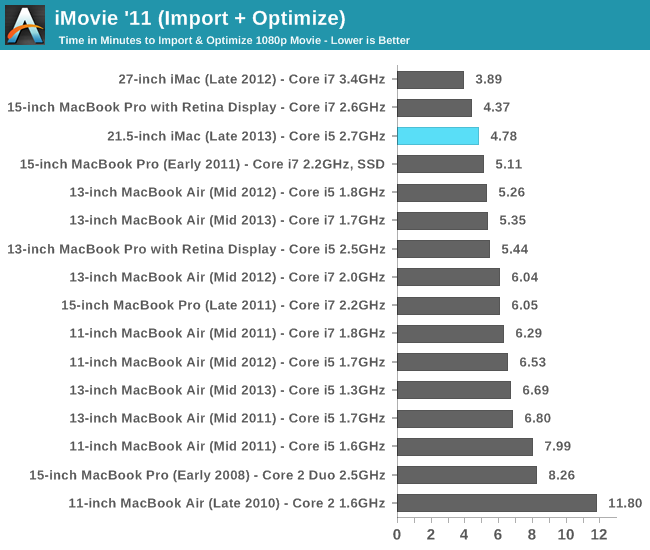
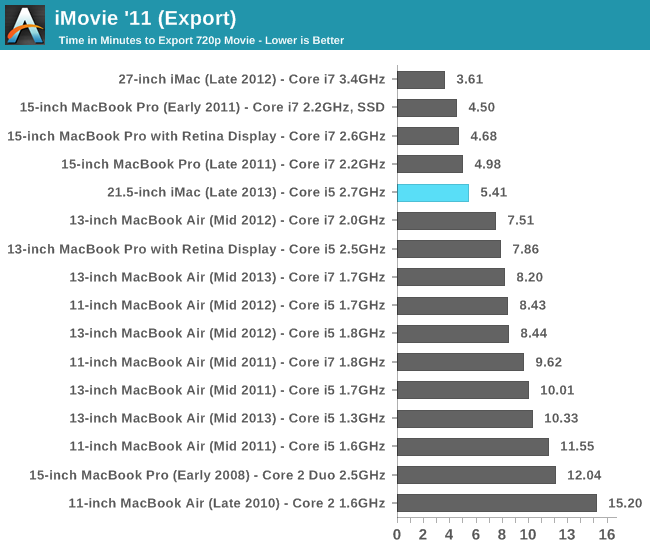
Looking at our iMovie test we see another 50% advantage comparing last year’s highest end 27-inch iMac configuration to the entry-level 21.5-inch model. The explanation boils down to lower max turbo frequencies and fewer number of simultaneous threads supported. There’s also the fact that I’m testing a HDD equipped system and comparing it to those with SSDs, but most of my OS X CPU test suite ends up being largely CPU bound with minimal impact from IO performance.

iPhoto import performance runs pretty much in line with what we’ve seen thus far. The entry-level iMac is a good performer, but power users will definitely want to push for a faster CPU.
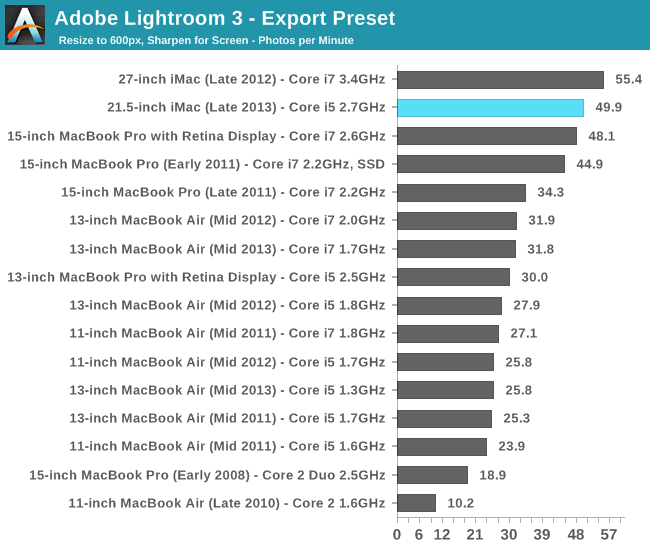
Our Lightroom export test is perhaps the most interesting here. The gap between last year’s 3.4GHz Core i7 and the Crystalwell equipped Core i5-4570R is only 12%. My first thought was to attribute the difference to Crystalwell, but if we look at the gap vs. the 1.7GHz 2013 MacBook Air the iMac’s advantage isn’t really any different than under our iPhoto test. Instead what I believe we’re seeing here is yet another benchmark where Haswell’s architectural advantages shine.
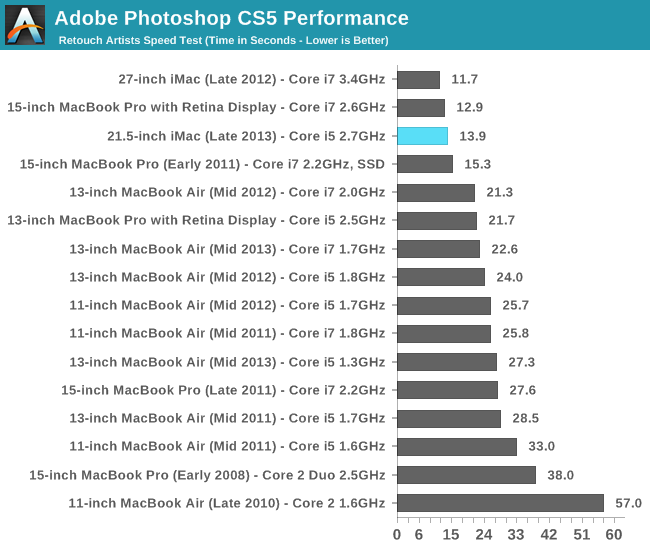
Performance in our Photoshop test is similarly good, with the entry-level iMac coming relatively close (within 20%) to the performance of a high-end 2012 27-inch iMac.
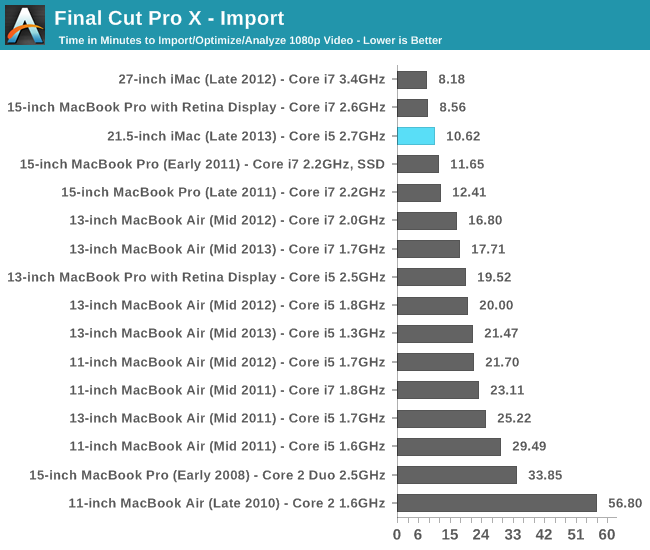
There aren’t any surprises in our FCP-X test either.
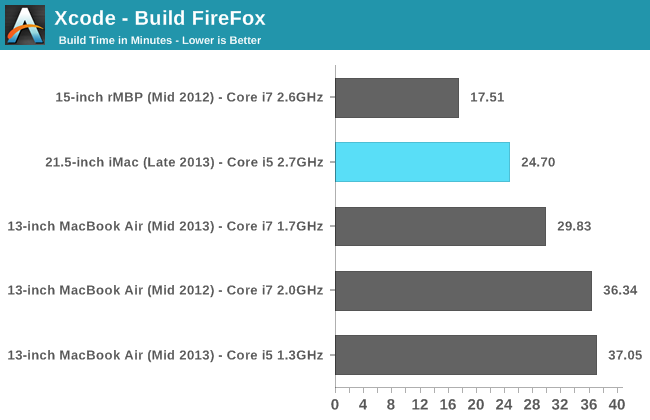
I'm slowly amassing results in our Xcode test. What's interesting about the 21.5-inch iMac's performance here is just how inconsistent it was due to the HDD. Subsequent runs either gave me similar performance to what I'm reporting here, or much, much higher build times. If you needed a reason to opt for an SSD, this is a great one. Even looking at the best performance the iMac can deliver, you can see it's not tremendously quicker than the MacBook Air. With an SSD I'd expect to see far better numbers here.










127 Comments
View All Comments
mschira - Tuesday, October 8, 2013 - link
Could one buy a super fast USB3 SSD and build ones' own fusion drive on the cheap?Cheers
M.
name99 - Wednesday, October 9, 2013 - link
Yes --- if you're willing to be daring.Essentially you'd need to boot off a third drive (or the network) then use diskutil cs commands to create an LVG then an LV tying the two drives together. There are instructions on the web giving details.
On a different point, I don't think Anand is correct in saying that Fusion works better than other hybrid solutions because it tracks blocks. I think the real answer is that it does a MUCH smarter job of tracking file "temperature". OSX has, since about 10.3, tracked file temperature (which is essentially a combination of how large the file is and how often it's accessed). This was done back then (and is still done) to move the hottest files to a small "hot files" area at the start of a disk for the obvious performance reasons.
Details here:
http://osxbook.com/book/bonus/misc/optimizations/#...
My guess is that Fusion essentially hooks into this mechanism, and just redefines the constants controlling how large the hot file area is to have it cover all of the SSD (minus of course the area for file system metadata, the area that is reserved for fast writes, and so on).
I can't think of any realistic situation (within pure OSX) where tracking by blocks rather than files is useful, and it would require a whole new way of looking at the problem. I think the obvious way to test this would be to look at the behavior of VM images which, assume, as a whole don't count as hot because they are very large, but which do have hot blocks inside them. If you look at IO when, say, starting up a VM, do you see all the IO coming from the HD, or do you see it all come from the SSD, with HD accesses coming later once the VM is booted and we're now pulling in less frequently accessed blocks?
Risas - Thursday, October 10, 2013 - link
What a silly review and comparison. Apple vs Apple, conclusión: the Moore's law still works.CPU performance: It look like Apple made any work instead of changing the Intel CPU, Apple CPU performance comparison? there's no other comparison of the Intel's CPUs? Just look at them, what to spect?
And over and over... Apple iMAc vs Apple iMacs, who wins? Apple, of course.
Final words..."Apple continues to have the strongest Mac lineup of its history" Does any other have MAC lineups? Of course no, as it's a monopolistic stuff. So It's unnecesary to say what's obvious.
Apple's Haswell?? yo write the article as if Apple did anything on the Haswell desing or manufacture.... Maybe Intel have to say something about it...
And here is what really matters: The iMac’s industrial design is beautiful.
No complains about the small breaking-wrist keyboard or any thing as Apple fights againts Apple it wold be always a winner: Apple.
Commodus - Thursday, October 17, 2013 - link
I'd say the Apple vs. Apple comparisons are valid because of the limited all-in-one market. It's hard to find something comparable; a lot of iMac alternatives are either budget models or use significantly different components (see the ASUS Transformer AIO or Lenovo IdeaCentre A730 as examples). The company practically dominates the category, at least in North America and Europe.Haplodepatrijn - Thursday, October 10, 2013 - link
Doses this mean we can finally use the GPU render in Blender ?shweetuant - Friday, October 25, 2013 - link
HiIf I am planning to install Windows 7 64-bit as virtual running side by side with OS X. Is the default 8GB of ram sufficient?
kkirk - Tuesday, December 3, 2013 - link
I was wondering if there will be a late 2013 Macbook Pro 15" review coming soon?